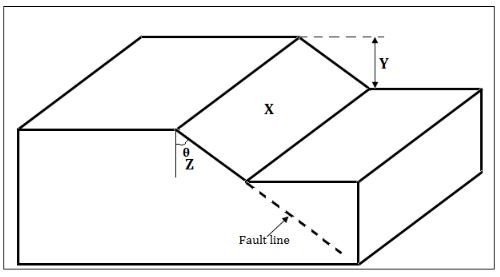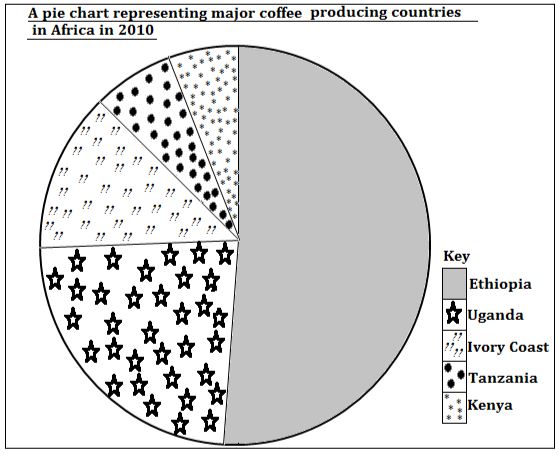GEOGRAPHY
Instructions:
Answer all the questions in the spaces provided.

Questions
-
- Give two dominant minerals in the outer core. (2 marks)
- Explain three reasons why the interior of the earth is very hot. (6 marks)
-
- Name three substances found in the atmosphere. (3 marks)
- State three characteristics of the troposphere layer of the atmosphere. (3 marks)
-
- What are metamorphic rocks? (2 marks)
- Explain how rocks influence the following:
- Agriculture (2 marks)
- Water storage. (2 marks)
- The diagram below shows a type of a fault. Use it to answer the question (a)
- Name the parts marked X, Y and Z. (3 marks)
- Give three features formed by vertical earth movements. (3 marks)
- You are to carry out a field study on faulting along a section on the Great Rift Valley in Kenya.
- Give three advantages of using observation as a method of data collection. (3 marks)
- State two follow up activities for the field study. (2 marks)
-
- Describe how an explosion crater is formed. (5 marks)
- Explain three causes of Vulcanicity. (6 marks)
-
- Apart from savannah, give three other major types of natural vegetation in Kenya. (3 marks)
- Describe the characteristics of savannah vegetation. (6 marks)
-
- State two main reasons why forest reserves were created in Kenya. (2 marks)
- Give three differences between softwood forests in Kenya with those in Canada. (6 marks)
- The table below shows major coffee producing countries in Africa in the year 2010.
COUNTRY PRODUCTION IN MILLION BAGS Ivory Coast 2.20 Kenya 0.85 Ethiopia 7.45 Tanzania 0.92 Uganda 3.10 - Calculate the percentage of the lowest coffee producer based on the information on the table. (2 marks)
- Using a radius of 5cm, draw a pie chart to present the information in the table. (9 marks)

Marking Scheme
-
- Give two dominant minerals in the outer core. (2 marks)
- Iron√
- Nickel√
- Explain three reasons why the interior of the earth is very hot. (6 marks)
- The earth still retains the original heat it had before cooling. During formation, the outer parts cooled faster than the inner parts thus retaining the heat at the centre. √√
- Due to the weight of the overlying materials on the crust which exerts a lot of pressure towards the centre of the earth. This generates a lot of heat in the interior. √√
- Breakdown of radioactive elements especially at the mantle region. This releases a lot of heat energy which is trapped in the interior. √√
- Give two dominant minerals in the outer core. (2 marks)
-
- Name two substances found in the atmosphere. (2 marks)
- Gases/air√
- Water vapour√
- Dust particles
- Smoke particles√
- Clouds √
- State three characteristics of the troposphere layer of the atmosphere. (3 marks)
- It is the lowest layer of the atmosphere. √
- It extends to about 10 – 12 km above the surface. √
- It experiences a normal lapse rate/temperature decreases with increase in height. √
- It contains 90% of the total moisture in the atmosphere. √
- It contains 75% of the air in the atmosphere. √
- Name two substances found in the atmosphere. (2 marks)
-
- What are metamorphic rocks? (2 marks)
- These are rocks formed when original igneous or sedimentary rocks have been altered by intense heat, pressure or both.
- These are rocks formed when original igneous or sedimentary rocks have been altered by intense heat, pressure or both.
- Explain how rocks influence the following:
- Agriculture (2 marks)
- Some rocks especially volcanic undergo weathering over long periods of time to form very rich and fertile soils that support a wide variety of crops. √√
- Some rocks especially volcanic undergo weathering over long periods of time to form very rich and fertile soils that support a wide variety of crops. √√
- Water storage. (2 marks)
- Permeable rocks where underlain by impermeable rocks hold and store ground water as aquifers. Such water forms vital springs or is drawn through boreholes for domestic, industrial or irrigation purposes. √√
- Permeable rocks where underlain by impermeable rocks hold and store ground water as aquifers. Such water forms vital springs or is drawn through boreholes for domestic, industrial or irrigation purposes. √√
- Agriculture (2 marks)
- What are metamorphic rocks? (2 marks)
- The diagram below shows a type of a fault. Use it to answer the question (a)
- Name the parts marked X, Y and Z. (3 marks)
- X – Escarpment/Fault scarp√
- Y – Throw√
- Z - Hade√
- Give three features formed by vertical earth movements. (3 marks)
- Basins/depressions√
- Fault scarps/escarpments √
- Horsts/Tilt blocks/Block mountains√
- Rift valleys √
- Submerged coasts√
- Emerged coasts. √
- Raised cliffs√
- You are to carry out a field study on faulting along a section on the Great Rift Valley in Kenya.
- Give three advantages of using observation as a method of data collection.
- Observation gives first hand data. √
- It is an easy method of collecting data. √
- A lot of data can be collected in one place. √
- New knowledge can be learnt through observation. √ (3 marks)
- State two follow up activities for the field study. (2 marks)
- Writing a report on data collected. √
- Analyzing and classifying the data collected√
- Displaying processed photographs taken during the study. √
- Conducting group discussions based on data collected. √
- Giving a lecture to other students. √
- Give three advantages of using observation as a method of data collection.
- Name the parts marked X, Y and Z. (3 marks)
-
- Describe how an explosion crater is formed. (5 marks)
- In some volcanic active zones, ground water and some gases may come in contact with hot magma. √
- The water and gases are intensely heated thus expand.
- This builds up intense pressure below the surface. √
- The pressure may move along lines of weakness towards the earth surface. √
- When this pressure is released near the ground level, a violent explosion occurs. √
- *The explosion blows out a large depression at the ground level called an explosion crater. √
- NB. *The last point with the must be given to score maximum marks
- Explain three causes of Vulcanicity. (6 marks)
- High temperatures in the interior of the earth which heats materials into molten form (magma).√√
- High pressure in the interior of the earth mainly due to earth movements which pushes igneous materials towards the crust. √√
- Faulting process which creates lines of weakness such as cracks, fissures and vents through which hot materials pass towards the crust/to the surface. √√
- Underground water which is heated by hot rocks to form steam which leads t the formation of hot springs, geysers and fumaroles. √√
- Describe how an explosion crater is formed. (5 marks)
-
- Apart from savannah, give three other major types of natural vegetation in Kenya. (3 marks)
- Forests√
- Arid and semi-arid vegetation√
- Heath and moorland√
- Swamp vegetation√
- Describe the characteristics of savannah vegetation. (6 marks)Savannah consists of a mixture of trees and grass. √
- Trees are of medium height.(10 – 13 metres) √
- The dominant tree species is acacia. √
- Most of the tree species are deciduous thus shed leaves during the dry season. √
- Most trees have needle like leaves to reduce water loss. √
- Tree crowns are umbrella shaped to provide shade so as to reduce evaporation around the trunk and roots. √
- In drier areas, trees are shorter and further apart. √In dry areas, baobab and bottle brush trees are evident. √
- In wetter areas, grass species are tall and green. √
- In drier areas, the grass is short, tough and dry. √
- In wet areas, grass species dominate under growths between trees. √
- Apart from savannah, give three other major types of natural vegetation in Kenya. (3 marks)
-
- State two main reasons why forest reserves were created in Kenya. (2 marks)
- To control soil erosion. √
- To protect water catchment areas. √
- Give three differences between softwood forests in Kenya with those in Canada. (6 marks)
- In Kenya, there are both indigenous and exotic tree species whereas in Canada, all tree species are indigenous. √√
- In Kenya, softwoods are mainly planted while in Canada, softwoods are mainly natural. √
- In Kenya, softwood tree species mature faster due to warm conditions/moderate to high temperatures whereas in Canada, softwoods take a longer duration to mature due to cold winters. √√
- In Kenya, softwoods are found in the Kenya highlands while in Canada, softwoods are found in both highlands and lowlands. √√
- In Kenya, softwood forests cover a very small percentage of total Kenya’s area whereas in Canada, softwoods cover a large percentage of Canada’s total area. √√
- In Kenya, there are fewer varieties of softwood tree species whereas in Canada, there is a wide variety of softwood tree species. √√
- State two main reasons why forest reserves were created in Kenya. (2 marks)
- The table below shows major coffee producing countries in Africa in the year 2010.
- Calculate the percentage of the lowest coffee producer based on the information on the table. (3 marks)
- Total 2.20 + 0.85 + 7.45 + 0.92 + 3.10 = 14.52 million bags √
Lowest coffee producer: Kenya
0.85 Million Bags X 100% = 5.85% √√
14.52 Million Bags
- Total 2.20 + 0.85 + 7.45 + 0.92 + 3.10 = 14.52 million bags √
- Using a radius of 5cm, draw a pie chart to present the information in the table. (9 marks)
- Calculations
Ethiopia: 7.45 Million Bags X 3600 = 184.70 √
14.52 Million Bags
Uganda: 3.10 Million Bags X 3600 = 76.90 √
14.52 Million Bag
Ivory Coast: 2.20 Million Bags X 3600 = 54.50 √
14.52 Million Bags
Tanzania: 0.92 Million Bags X 3600 = 22.80 √
14.52 Million Bags
Kenya: 0.85 Million Bags X 3600 = 21.10 √
14.52 Million Bags - Calculations: 5 marks
Sectors 3 marks
Title 1 mark
TOTAL 9 marks
- Calculations
- Calculate the percentage of the lowest coffee producer based on the information on the table. (3 marks)
Join our whatsapp group for latest updates
Tap Here to Download for 50/-
Get on WhatsApp for 50/-
Download Geography Questions and Answers - Form 3 Opener Term 1 Exams 2022.
Tap Here to Download for 50/-
Get on WhatsApp for 50/-
Why download?
- ✔ To read offline at any time.
- ✔ To Print at your convenience
- ✔ Share Easily with Friends / Students



